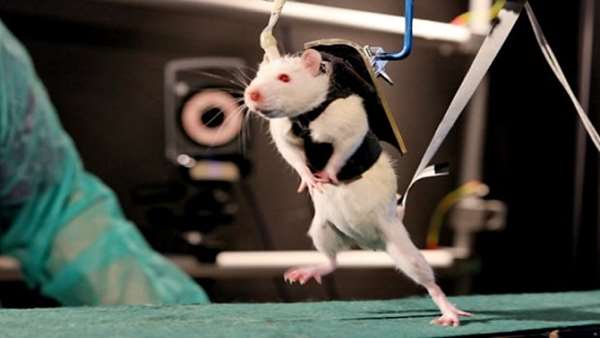Paraplegic Rats Walk and Regain Feeling After Stem Cell Treatment
Spinal cord injuries often lead to paraplegia. Achieving substantial recovery following a complete spinal cord tear, or transection, is an as-yet unmet challenge.
Spinal cord injuries often lead to paraplegia. Achieving substantial recovery following a complete spinal cord tear, or transection, is an as-yet unmet challenge.
Led by Dr. Shulamit Levenberg, of the Technion-Israel Institute of Technology, the researchers implanted human stem cells into rats with a complete spinal cord transection. The stem cells, which were derived from the membrane lining of the mouth, were induced to differentiate into support cells that secrete factors for neural growth and survival.
The work involved more than simply inserting stem cells at various intervals along the spinal cord. The research team also built a three-dimensional scaffold that provided an environment in which the stem cells could attach, grow and differentiate into support cells. This engineered tissue was also seeded with human thrombin and fibrinogen, which served to stabilize and support neurons in the rat’s spinal cord.
Rats treated with the engineered tissue containing stem cells showed higher motor and sensory recovery compared to control rats. Three weeks after introduction of the stem cells, 42% of the implanted paraplegic rats showed a markedly improved ability to support weight on their hind limbs and walk. 75% of the treated rats also responded to gross stimuli to the hind limbs and tail.
In contrast, control paraplegic rats that did not receive stem cells showed no improved mobility or sensory responses.
In addition, the lesions in the spinal cords of the treated rats subsided to some extent. This indicates that their spinal cords were healing.
While the results are promising, the technique did not work for all implanted rats. An important area for further research will be to determine why stem cell implantation worked in some cases but not others. As the research team notes, “This warrants further investigation to shed light on the mechanisms underlying the observed recovery, to enable improved efficacy and to define the intervention optimal for treatment of spinal cord injury.”
Although the study in itself does not solve the challenge of providing medical treatments for spinal cord injury in humans, it nevertheless points the way to that solution. As Dr. Levenberg puts it: “Although there is still some way to go before it can be applied in humans, this research gives hope.”
Reference: https://www.frontiersin.org/articles/10.3389/fnins.2017.00589/full





ارسال به دوستان